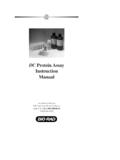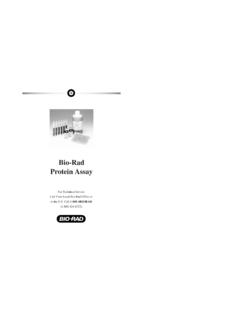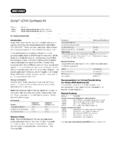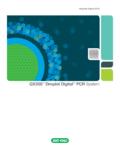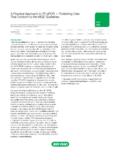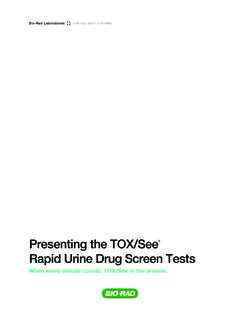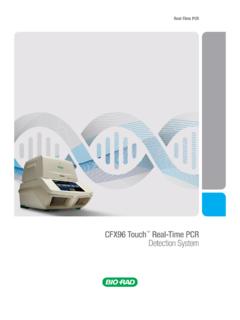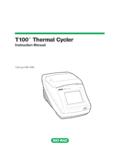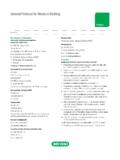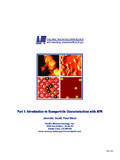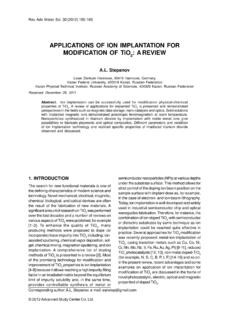Transcription of Transfection Methods Overview - Bio-Rad
1 Methods MethodsOverview2 OverviewCommon Transfection MethodsReagent-Based MethodsLipidsCalcium phosphateCationic polymersDEAE-dextranActivated dendrimersMagnetic beadsInstrument-Based MethodsElectroporationBiolistic technologyMicroinjectionLaserfection/opt oinjectionVirus-Based Methods41 Terminology2 Factors Affecting TransfectionHost CellCell healthCell cultureGenetic MaterialDNA quality and quantityTransfection : introduction of foreign DNA into the nucleus of eukaryotic cells. Cells that have incorporated the foreign DNA are called transfectants: Cells that have integrated foreign DNA in their transfectants: Foreign DNA does not integrate in the genome but genes are expressed for a limited time (24 96 hours).
2 TerminologyTransfection MethodsTerminology4 Transfection Affecting Transfection5 Host CellCell healthCell cultureGenetic MaterialDNA quality and quantityFactors Affecting Transfection2 Transfection CellCell Health Cells should be grown in appropriate medium with all necessary factors Cultures must be free of contamination Fresh medium must be used if it contains chemically unstable components, such as thiamine Cells should be incubated at 37 C with CO2 supplied at the correct percentage (5 10%) and 100% relative humidity Cells should be maintained in log phase growthCell HealthFactors Affecting Transfection6 Transfection CultureConfluency and Growth Phase Cells should be transfected at 40 80% confluency (cell type dependent) Too few cells cause cell cultures to grow poorly without cell-to-cell contact Too many cells result in contact inhibition, making cells resistant to uptake of DNA and other macromolecules Actively dividing cells take up DNA better than quiescent cells (breakdown and perforation of the nuclear membrane during mitosis enable nuclear delivery)Number of Passages for Primary Cells The number of passages should be low (<50)
3 The number of passages for cells used in a variety of experiments should be consistent Cell characteristics can change over time with immortalized cell lines and cells may not respond to the same Transfection conditions Cells may not respond to the same Transfection conditions after repeated passagesHost CellCell CultureFactors Affecting Transfection7 Transfection Quality and Quantity Use high-quality plasmid DNA that is free of proteins, RNA, and chemicals for transfections; endotoxin removal should be part of the preparation procedure Typically, DNA is suspended in sterile water or TE buffer to a final concentration of 1 mg/ml The optimal amount of DNA to use in the Transfection will vary widely depending upon the type of DNA, Transfection reagent/method, target cell line.
4 And number of cellsGenetic MaterialDNA Quality and QuantityFactors Affecting Transfection8 Transfection Methods | OverviewTransfection Workflow9 Transfection cultureCount cells Resuspend cells inelectroporation bufferAdd nucleic acidTransfect cellsPlate cellsAnalysisProtein expressionGene expressionReporter gene activityWestern blot analysisMicroscopyFlow cytometryReal-time qPCRT ransfection WorkflowTransfection MethodsTransfection WorkflowTransfection Workflow10 Transfection Methods | OverviewTransfection MethodsLipids Calcium phosphateCationic polymersDEAE-dextranActivated dendrimersMagnetic beadsInstrument-Based MethodsElectroporationBiolistic technologyMicroinjectionLaserfection/opt oinjectionVirus-Based MethodsCommon Transfection MethodsCommon Transfection Methods411 Transfection Lipids.
5 Liposomes/Lipoplexes Cationic lipids are amphiphilic molecules that have a positively charged polar head group linked, via an anchor, to an apolar hydrophobic domain generally comprising two alkyl chains Structural variations in the hydrophobic domain of cationic lipids include the length and the degree of non-saturation of the alkyl chains Electrostatic interactions between the positive charges of the cationic lipid head groups and the negatively charged phosphates of the DNA backbone are the main forces that allow DNA to spontaneously associate with cationic lipidsLipidsReagent-Based MethodsCommon Transfection Methods12 Transfection Gene DeliveryLipid-mediated gene delivery is also referred to as lipofection, or liposome-based gene Transfection .
6 It uses lipids to cause a cell to absorb exogenous DNA. Transfer of genetic material into the cell takes place via liposomes, which are vesicles that can merge with the cell membrane since they are both made of a phospholipid MethodsCommon Transfection MethodsNucleic acidTransfectionEndocytosisCationic lipidLiposomeAnalysisComplexing13 Transfection ASolution BPlated cellsAspirate medium from cellsIncubate overnight and 1 g plasmid DNA per 50 l serum-free mediumMix equal volumes of TransFectin and DNA solutionsIncubate 20 min to form DNA-liposome complexesMix; add DNA-liposome complexes directly to cells (100 l/24-well plate)2 4 l Transfectin lipid reagent per 50 l serum-free mediumLipidsReagent-Based MethodsCommon Transfection Methods14 Method OverviewTransfection and ConsAdvantages of Lipids Deliver nucleic acids to cells in a culture dish with high efficiency Easy to use, minimal steps required.
7 Adaptable to high-throughput systems Using a highly active lipid will reduce the cost of lipid and nucleic acid, and achieve effective resultsDisadvantage of Lipids Not applicable to all cell typesLipidsReagent-Based MethodsCommon Transfection Methods15 Transfection PhosphateThe protocol involves mixing DNA with calcium chloride, adding this in a controlled manner to a buffered saline/phosphate solution, and allowing the mixture to incubate at room temperature. This step generates a precipitate that is dispersed onto the cultured cells. The precipitate is taken up by the cells via endocytosis or PhosphateReagent-Based MethodsCa++Ca++Ca++Ca++Calcium phosphateCa++Ca++DNAC ommon Transfection Methods16 Transfection PhosphateReagent-Based MethodsMethod OverviewSolution A: DNA in calcium solutionSolution B: 2x Hanks buffered saline solution1 Add solution A to solution B while Incubate 20 30 min.
8 Apply the solution to a subconfluent cell Incubate 2 12 hr. Replace the solution with complete growth Assay for transient gene expression or begin selection for stable transformation Transfection MethodsSolution AStep 1 Step 2 Step 3 Step 4 Solution B17 Transfection and ConsAdvantages of Calcium Phosphate Inexpensive High efficiency (cell type dependent) Can be applied to a wide range of cell types Can be used for transient and stable transfectionDisadvantages of Calcium Phosphate Reagent consistency is critical for reproducibility Small pH changes ( ) can compromise transformation efficiency Size and quality of the precipitate are crucial to the success of Transfection Calcium phosphate precipitation does not work in RPMI, due to the high concentration of phosphate within the mediumCalcium PhosphateReagent-Based MethodsCommon Transfection Methods18 Transfection PolymersCationic polymers differ from cationic lipids in that they do not contain a hydrophobic moiety and are completely soluble in water.
9 Given their polymeric nature, cationic polymers can be synthesized in different lengths, with different geometry (linear versus branched). The most striking difference between cationic lipids and cationic polymers is the ability of the cationic polymers to more efficiently condense are three general types of cationic polymers used in transfections: Linear (histone, spermine, and polylysine) Branched SphericalCationic polymers include polyethyleneimine (PEI) and PolymersReagent-Based MethodsCommon Transfection Methods19 Transfection +CH2CH3 DiethylaminoethylDEAE-DextranReagent-Bas ed MethodsDextranDEAE-DextranDEAE-dextran is a cationic polymer that tightly associates with negatively charged nucleic acids.
10 The positively charged DNA:polymer complex comes into close association with the negatively charged cell membrane. DNA:polymer complex uptake into the cell is presumed to occur via endocytosis or macropinocytosis. Common Transfection MethodsDEAE-DextranReagent-Based MethodsMethod OverviewSolution A: DNA (~1 5 g/ml) diluted into 2 ml of growth medium with serum containing chloroquineSolution B: DEAE-dextran solution (~50 500 g/ml)Solution C: ~5 ml of DMSOS olution D: Complete growth medium1 Add solution A to solution B, then mix Aspirate cell medium and apply the mixed A and B solutions to the subconfluent cell culture. Incubate the DNA mixture for ~4 Aspirate Add solution C to induce DNA Remove DMSO and replace with complete growth medium.
